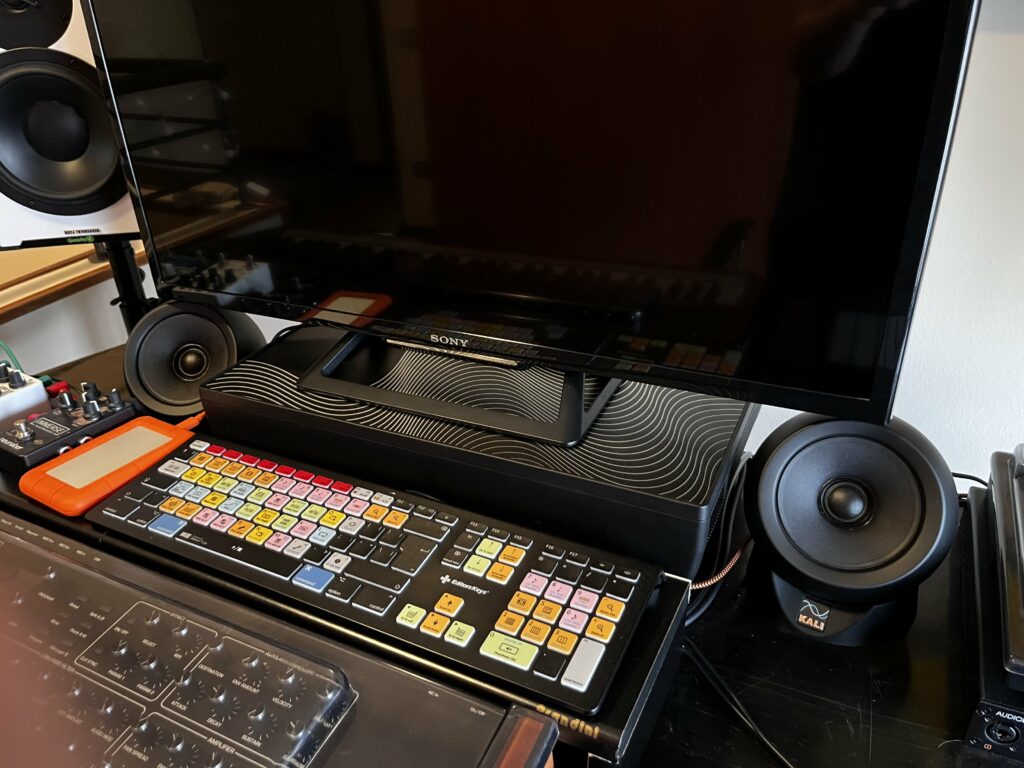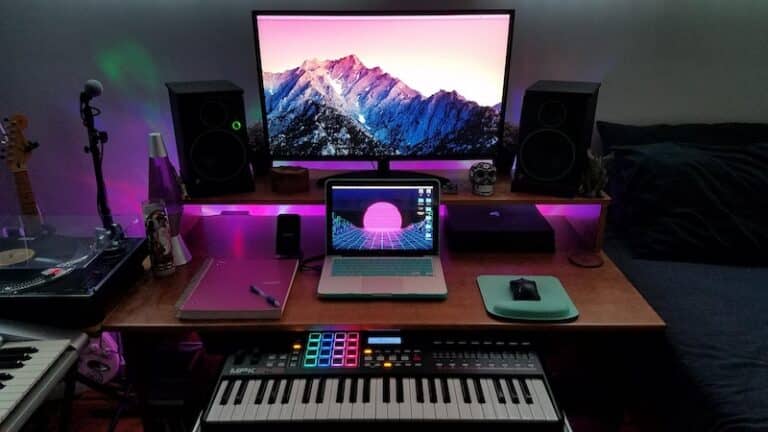Last Updated on April 12, 2024 by IDS Team
It’s now easier than ever to become a bedroom producer, but with so many options, there can sometimes be very little guidance as to how to get started. A good bedroom producer setup should be in tune with you musically. You should also think it out beforehand so you know it will work with your musical goals. Then, you won’t make any unnecessary investments.
This article will take you through the basic steps of setup, creating a place to mix and master, and how to tackle the challenges if you are a bedroom producer, don’t have budget to master, or can’t afford much analog gear.
We’ll also touch on some of the best plugins, whether there is any given genre for a bedroom producer and more. Plus, we’ll look at the easiest way to cover every part of the signal chain for cheap, and what to do if you don’t have space for a proper studio, so read on for the comprehensive guide and some tips for getting started.
So you want to create a home studio
So you want to create a home studio and become a bedroom producer. Even though this might sound like it will cost a huge amount of money, it’s really not that hard. One of the biggest considerations is soundproofing and finding the pace where you can safely keep your gear, as well as setting up a monitor for your DAW and finding an area for taking good recordings, whether vocals or mic’ing up an amp.
Soundproofing a bedroom producer setup
Soundproofing is one of the hardest parts of setting up a home studio and often one of the costliest. You can minimize a lot of the cost simply by choosing the right space to begin with.
If you’re a bedroom producer, you most likely won’t be able to soundproof your room fully. Normally, soundproofing involves the use of a floating floor and floating walls so there is a gap between the walls and floor of your studio and the main part of the house. This prevents sound traveling through the walls to the space you’ll be recording in.
If you can’t manage this, then, how do you soundproof a room? You will need to simply add more mass to muffle the acoustics. You can do this by adding floating fabric panels to the walls or at least one wall, as well as investing in a mic shield and pop filter for when you are recording vocals.
Monitors
Finding a good pair of monitors is always important! If you’re really on a budget, you may be able to skip this step and just listen to your music through a pair of high-quality producers’ headphones. However, if you’re really serious, it’s best to ultimately invest in a good pair of studio monitors that will allow you to hear your track out loud, like your listeners may do.
How to choose monitors for your bedroom producer setup
Essentially, you can expect to pay up to around 300 USD for monitors at a beginner level, but that’s not including the costs of other parts of your monitor setup such as mounting them on stands or the foam cushioning needed for this. Brands like Yamaha and IK Multimedia do affordable budget monitors that are ideal for beginner home producers.

With monitors, you should consider whether you want active or passive speakers. Passive speakers are less expensive, but each variety of speaker or monitor comes with its pros and cons. Passive speakers have to be plugged into an external power socket whereas active speakers have an in-built battery and therefore don’t require external cables for the amplifier.
Most studio monitors are active and that’s because passive monitors have to be split into multiple components such as subwoofers or eternal amplifiers and so on. This also means that matching impedance within your speaker and amplifier is important so opting for passive monitors, although initially cheaper, is more complex. However, some prefer them as they offer more sonic flexibility over actives.
Space Consideration For Your Bedroom Producer Setup
When setting up as a bedroom producer, there are a few extra things you should consider in terms of space. Even if you don’t have the ability or budget to put extensive soundproofing in because you’re in a flatshare or similar, you can still do your best to ensure the best sound simply by looking around the room.
One thing you will have to look out for is standing waves, which can cause interference when sound waves bounce off the walls. This means your mics then sense them. You can do this by positioning your set-up away from any major reflective surfaces. When you position your monitors, they’ll also have to be at least half a meter away from the wall and pointed toward where you will be sitting to produce. Therefore, consider where in your space you set up with reference to the entirety of your workflow.
Gear
When choosing gear for your bedroom producer setup or home studio, you may have a limited budget and limited space. As a result, think carefully about what you want hardware gear for, how often you will use it, and your genre. What things do you have to have and what can you find a VST substitute for? There are some great VSTS out there on the market now and you may not necessarily have to get the hardware version. There are no specific bedroom producer plugins, although it sometimes hints at lofi, bedroom producer setup does not imply a genre so focus on what you would want to buy as hardware instruments and take it from there.
That said, some of the top things we think it is good to have hardware of simply because of the scope of sound include a good hardware synth, depending on your genre, one or two amps and the necessary mics for them, and potentially a drum set depending on the genre you are using. You may also like something like Ableton Push depending on your preferred style of working.
One of the most crucial bits of hardware you will have to get is a MIDI keyboard. Yes, you can go without one, by entering notes manually on your laptop or by only using analog recording, but it broadens the scope of instruments you can use and saves you time.
Mastering
You may wonder whether it’s worth getting any gear for mastering. You may be a bedroom producer, don’t have budget to master, or don’t want to get into the complexities of the mastering process. Don’t worry. Mastering is a process all of its own and in professional studios artists do it with a mastering engineer who specifically on focuses on this. You can substitute with an online mastering service such as the many you can find reviewed on this blog.
Remember, there is no right or wrong genre for a bedroom producer. However, some genres might require more analog gear that takes up more space, such as a classic rock band with a full drum kit set up. If you’re stuck, remember you can get a lot of these classic instruments as really good true-to-life emulations.
Common Mistakes Before Bedroom Producer Setup
There are lots of great products and places for advice on how to start with a home studio setup. However, there are also some common pitfalls to avoid. Though by no means exhausted, some of the ones to watch out for as a bedroom producer just starting out are:
Not doing enough research
Research, research research! How can you know what gear would suit your setup best until you have tried it out? To fully get your space in order, it’s best not just to read reviews (although we have some great ones here) but also to do physical research, watch tutorials, and so on.
Think about what you want – is tone and technically a big deal or are you just making a studio for fun? Is versatility most important or do you need specialist gear for a niche genre? Knowing also what gear works with your space in terms of acoustics as well as different types of technology such as active or passive speakers will also help you decide, as well as knowing your genre for a bedroom producer setup.
Not Understanding Sound And Signal Flow
It may sound obvious, but in the excitement of buying gear it’s easy to forget this. Having a basic knowledge of signal flow from your mic to your monitors – whether that’s a mic for vocals or a drum kit or amp – is crucial. This will allow you to see how your gear fits together, where you will work, and so on.
Understanding basic sonic concepts like decibels, ohms, and standing waves will also allow you to get to grips with your monitors and the sound of your space and therefore let you choose your gear and setup more wisely. Yes, you can learn this stuff as you go along. But doing a bit of research can take you a long way.
Trying to cut costs
Whilst this may be tempting if you can’t wait to get producing, trying to cut costs may hold you up further down the line as you end up with gear that doesn’t work the way you want or suit your workflow. Yes, it can be fun to have lots of gear, but in a limited space you may find that something that isn’t right for you means there are gaping holes left up in your setup before you research this.
Conclusion
All in all, one of the hardest parts of being a bedroom producer or creating a home studio is the actual getting started. As it sometimes means you have to prepare your space beforehand, it may not seem like you have the opportunity. However, with some smart thinking, even the smallest space can be converted into a decent home studio for a relatively low cost. Plus, this can be one that will hopefully inspire you and get you in the mood for creating killer mixes right from the comfort of your bedroom.
Like tutorials? Remember, we have a whole section here.



